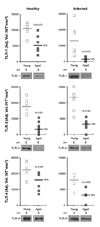Age-associated inflammation and toll-like receptor dysfunction prime the lungs for pneumococcal pneumonia
- PMID: 19586419
- PMCID: PMC3102250
- DOI: 10.1086/600870
Age-associated inflammation and toll-like receptor dysfunction prime the lungs for pneumococcal pneumonia
Abstract
Background: Aging is associated with increased inflammation and risk of community-acquired pneumonia. Streptococcus pneumoniae co-opts the nuclear factor kappa B (NFkB)-regulated proteins polymeric immunoglobulin receptor (pIgR) and platelet-activating factor receptor (PAFr) to attach and invade cells. We sought to determine whether aging and chronic inflammation were associated with increased pIgR and PAFr levels in the lungs and increased susceptibility to S. pneumoniae infection.
Methods: Lung protein and messenger RNA levels were quantitated using Western blot and quantitative polymerase chain reaction. NFkB activation was measured by electrophoretic mobility shift assay. Cytokine levels were measured by cytometric bead analysis. To model chronic inflammation, mice were implanted with osmotic pumps that delivered tumor necrosis factor-alpha.
Results: Aged mice and those infused with tumor necrosis factor-alpha had increased levels of pIgR and PAFr in their lungs and were more susceptible to S. pneumoniae infection. During pneumonia, aged mice had reduced levels of pIgR and PAFr and less NFkB activation, despite greater bacterial burden. We determined that aged mice had decreased amounts of lung Toll-like receptors 1, 2, and 4 and reduced capacity to respond to S. pneumoniae with proinflammatory cytokine production.
Conclusions: Aged mice and, potentially, elderly humans are more susceptible to pneumonia because of a priming effect of chronic inflammation and Toll-like receptor dysfunction.
Conflict of interest statement
Figures







Similar articles
-
Nuclear factor-kappaB activation in mouse lung lavage cells in response to Streptococcus pneumoniae pulmonary infection.Crit Care Med. 2000 Sep;28(9):3249-56. doi: 10.1097/00003246-200009000-00021. Crit Care Med. 2000. PMID: 11008989
-
Cellular senescence increases expression of bacterial ligands in the lungs and is positively correlated with increased susceptibility to pneumococcal pneumonia.Aging Cell. 2011 Oct;10(5):798-806. doi: 10.1111/j.1474-9726.2011.00720.x. Epub 2011 Jun 14. Aging Cell. 2011. PMID: 21615674 Free PMC article.
-
Involvement of the platelet-activating factor receptor in host defense against Streptococcus pneumoniae during postinfluenza pneumonia.Am J Physiol Lung Cell Mol Physiol. 2006 Jan;290(1):L194-9. doi: 10.1152/ajplung.00050.2005. Epub 2005 Aug 12. Am J Physiol Lung Cell Mol Physiol. 2006. PMID: 16100290
-
Prevotella intermedia induces severe bacteremic pneumococcal pneumonia in mice with upregulated platelet-activating factor receptor expression.Infect Immun. 2014 Feb;82(2):587-93. doi: 10.1128/IAI.00943-13. Epub 2013 Nov 18. Infect Immun. 2014. PMID: 24478074 Free PMC article.
-
Exposure to welding fumes and lower airway infection with Streptococcus pneumoniae.J Allergy Clin Immunol. 2016 Feb;137(2):527-534.e7. doi: 10.1016/j.jaci.2015.06.033. Epub 2015 Aug 12. J Allergy Clin Immunol. 2016. PMID: 26277596 Free PMC article.
Cited by
-
Retinoic acid treated human dendritic cells induce T regulatory cells via the expression of CD141 and GARP which is impaired with age.Aging (Albany NY). 2016 Jun;8(6):1223-35. doi: 10.18632/aging.100973. Aging (Albany NY). 2016. PMID: 27244900 Free PMC article.
-
Respiratory microbiota dynamics following Streptococcus pneumoniae acquisition in young and elderly mice.Infect Immun. 2014 Apr;82(4):1725-31. doi: 10.1128/IAI.01290-13. Epub 2014 Feb 10. Infect Immun. 2014. PMID: 24516113 Free PMC article.
-
Weakened Airway Epithelial Junctions and Enhanced Neutrophil Elastase Release Contribute to Age-Dependent Bacteremia Risk Following Pneumococcal Pneumonia.Aging Cell. 2025 May;24(5):e14474. doi: 10.1111/acel.14474. Epub 2025 Jan 8. Aging Cell. 2025. PMID: 39778043 Free PMC article.
-
Impact of oral simvastatin therapy on acute lung injury in mice during pneumococcal pneumonia.BMC Microbiol. 2012 May 15;12:73. doi: 10.1186/1471-2180-12-73. BMC Microbiol. 2012. PMID: 22587610 Free PMC article.
-
Aging promotes B-1b cell responses to native, but not protein-conjugated, pneumococcal polysaccharides: implications for vaccine protection in older adults.J Infect Dis. 2014 Jan 1;209(1):87-97. doi: 10.1093/infdis/jit442. Epub 2013 Aug 20. J Infect Dis. 2014. PMID: 23964109 Free PMC article.
References
-
- Janssens JP. Pneumonia in the elderly (geriatric) population. Curr Opin Pulm Med. 2005;11:226–230. - PubMed
-
- Pneumococcal vaccines. WHO position paper. Wkly Epidemiol Rec. 1999;74:177–183. - PubMed
-
- Edwards KM. Pneumococcal infections: Therapeutic strategies and pitfalls. In: Tuomanen EI, Mitchell TJ, Morrison DA, Spratt BG, editors. The Pneumococcus. Washington D.C.: ASM Press; 2004. pp. 314–330.
-
- Active Bacterial Core Surveillance (ABCs) Centers for Disease Control and Prevention; 2007. Report Emerging Infections Program Network Streptococcus pneumoniae, 2006.
Publication types
MeSH terms
Substances
Grants and funding
LinkOut - more resources
Full Text Sources
Medical
Miscellaneous

